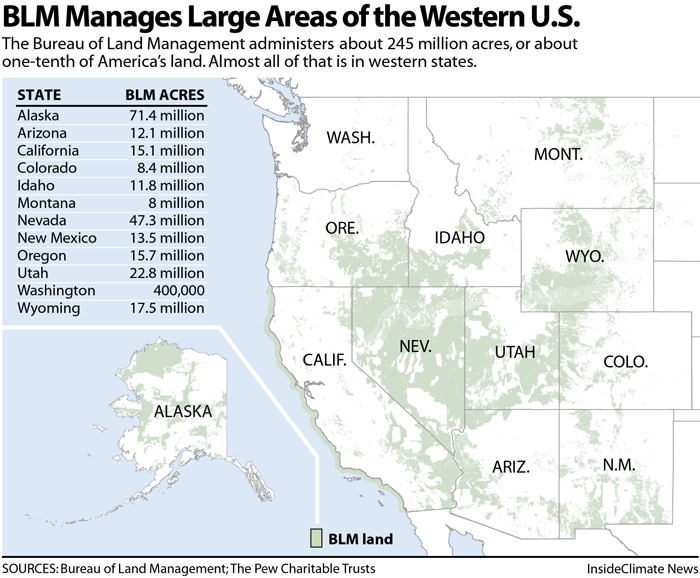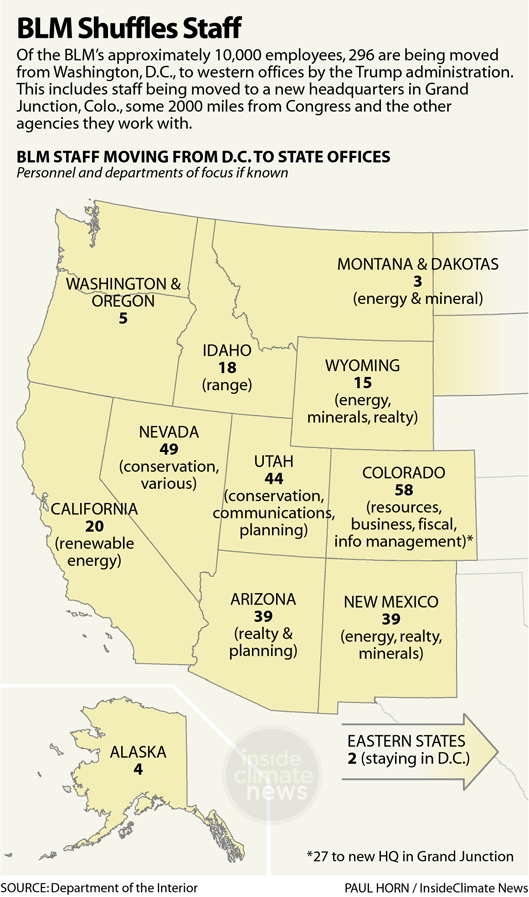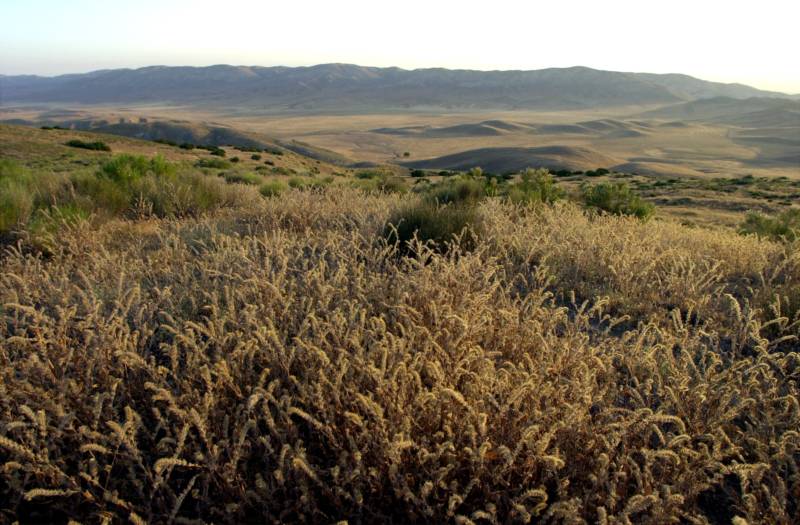The Trump administration and its supporters say reorganizing the BLM will improve the efficiency and effectiveness of natural resource programs, including grazing, logging and managing federal coal, oil and gas development.
The bureau is tasked under the Federal Land Planning and Management Act with balancing that resource extraction with recreational and environmental values, including wildlife conservation and cultural resource protection. The changes could tilt that balance further toward industry interests.
Jayson O’Neill, deputy director of the left-leaning public lands advocacy group the Western Values Project, described the BLM reorganization as “lands-transfer lite.” Some Westerners have demanded that the federal government hand over title to public land to the states. The Trump administration rejected that idea early on, but “transfer-lite” amounts to a compromise that gives states more control over natural resources on federal lands, he said.
The states’ mandate “is to generate revenue, which is a lot different than the mandate of the Bureau of Land Management … to balance uses,” O’Neill said. He sees the reorganization as an “attack on our public lands so that extractive resource industries and the oil and gas industry can control public lands without public input.”
The BLM did not respond to requests for comment. But Sen. Cory Gardner (R-Colo.) articulated the thinking behind the move in a video posted on Twitter in July after the BLM announced its new Grand Junction headquarters.
“This means that people will be able to have greater say, greater impact on public lands decisions that affect their community,” he said.
The BLM had considered climate change impacts in its decisions until the Trump administration shifted its focus toward “energy dominance.”
“American energy production is soaring to new heights thanks to President Trump’s policies,” proclaimed a White House fact sheet touting a record $1.1 billion in revenue from onshore oil and gas lease sales last year.
A ‘Sage Brush Rebel’ in Charge
Shifting more BLM resources to western states is a boon for states’ rights advocates.
So was the appointment of William Perry Pendley to lead the reorganization as acting director of BLM. Pendley, who calls himself @Sagebrush_Rebel on Twitter, has authored five books arguing for limiting federal control of public lands, including, most recently, Warriors for the West: Fighting Bureaucrats, Radical Groups and Liberal Judges on America’s Frontier.
In the Reagan Interior Department, Pendley was Secretary James Watt’s deputy. He later followed Watt as head of the Mountain States Legal Foundation. Under his leadership, MSLF became a staunch advocate for private-property rights, federal-lands transfer and the New Sagebrush Rebellion—ideas that resurfaced in the public consciousness in recent years by extremists in the Cliven Bundy armed standoff with the BLM and the Malheur National Wildlife Refuge occupation.
“I see the reorganization as an effort to get the land managers closer to the lands they’re managing,” said Jennifer Fielder, a GOP state senator in Montana and director of the conservative American Lands Council, a nonprofit that’s led the “lands transfer” movement to have states assume ownership of most federal lands. “It’s good to have somebody at the agency who’s looking out for the citizens.”
Jeff Ruch, western director for the nonprofit Public Employees for Environmental Responsibility, said having Pendley at the BLM “is all about an extractive agenda, an industry agenda.”
Isolated BLM Staff
Staff at BLM headquarters work closely with other federal agencies, and they are responsible for briefing Congress and the White House Office of Management and Budget (OMB). They also convey the policy goals of agency leaders at the Interior Department, which oversees BLM.
Most of the relocated headquarters staff is being dispersed to 11 state offices in the West that 97 percent of BLM’s approximately 10,000 employees already report to. Just over two dozen will relocate to the new Colorado headquarters, where co-tenants include Chevron USA, an oil and gas company, and the local branch of an energy-industry trade group. The site is midway between Denver and Salt Lake City and a four hour drive to the nearest major airport.
That isolation is a concern, said Elaine Zielinski, a member of the Public Lands Foundation, a nonpartisan association of former BLM managers.
She worries that locating the agency so far from Washington will undermine BLM’s communications with national decision makers, including Congress, White House budget-makers and partner agencies like the Environmental Protection Agency and the Fish and Wildlife Service.
Many important conversations about policies, budget and congressional oversight are “on D.C. time,” said Zielinski, who led BLM’s Oregon and Arizona state offices and worked at Washington headquarters. Staffers were expected to brief national decision makers at a moment’s notice, and if knowledgeable staffers didn’t get there within an hour, she said, “Don’t bother. They’ve moved on.”
“With Congress, you have a short window to answer these questions, and also with OMB,” she said. With the reorganization, “all the people who have the answers are scattered all over the country.”
Getting Staff to Quit
Conservative groups like the Heritage Foundation and the American Legislative Exchange Council have been advocating for shifting power out of Washington and for shrinking the federal government, and the BLM reorganization can be seen as another move toward those goals.
BLM headquarters employees began receiving relocation notices a few weeks ago, and some are likely to decline new postings rather than uproot their families.
When two Agriculture Department agencies were reassigned from Washington to Kansas City, two-thirds of the staff refused to relocate.
Mick Mulvaney, acting chief of staff to the president, described relocating staff like that as “a wonderful way to sort of streamline government” by getting federal employees to quit.
Shifting power to the states is also a longtime goal of some conservative groups. The Trump administration has moved in that direction with the Shared Stewardship forest program, for instance, and beefing up the presence of local government on the Bears Ears National Monument management council. Recent proposals in Congress would also put state and local government in charge of energy management and law enforcement on federal lands.
Martin Nie, director of the University of Montana’s Bolle Center for People and Forests, said the BLM reorganization is the administration’s latest nod to Sagebrush Rebels and states’ rights conservatives.
“We have seen an unprecedented transfer of management authority from the federal government to the states,” he said, counting the BLM reorganization as the latest example.
Western Voters
Empowering states, reducing the role of the federal government, expanding public lands energy development—while those ideas resonate in western states, what might be even more important to conservatives is the role the BLM reorganization can play in shoring up the conservative vote in 2020.
Republicans stand to lose Senate seats in Colorado and Arizona if their voters don’t turn out. In the U.S. House, the GOP sees winnable Democratic seats in Utah, New Mexico, Arizona and Nevada. Montana’s sole House seat, held by a Republican now, is considered a tossup. Meanwhile, Nevada and Arizona are both considered swing states in 2020 presidential race.
With the reorganization shifting BLM headquarters and staff to their states, it could appear to conservative voters that the Trump administration is listening to their pleas to give states more influence over federal land.



